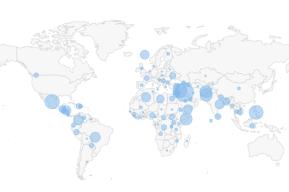
Observatory of Killed Journalists
This Observatory provides updated information on the killing of journalists since 1993 and on the judicial status of condemned cases since 2006. It also provides public access to country responses to UNESCO's requests for information into the judicial status of ongoing and unresolved cases. You may browse the full list of killed journalists and search for visual statistics and data.
This Observatory makes publicly accessible UNESCO’s work on monitoring and reporting on the safety of journalists, as well as on global impunity for these crimes, data which is largely collected through the Director-General's Report on the Safety of Journalists and the Danger of Impunity. It forms an essential part of the implementation of the UN Action Plan on the Safety of Journalists and the Issue of Impunity.
UNESCO condemns the killing of journalists
Recording Killings of Journalists
The term journalist in UNESCO's monitoring and reporting mechanisms covers “journalists, media workers and social media producers who are engaged in journalistic activity”, in line with IPDC Decisions on the Safety of Journalists and the Issue of Impunity adopted by the IPDC Council in 2008, 2010, 2012, 2014, 2016, 2018, 2020 and 2022. This definition also aligns with General Comment No. 34's broad interpretation of journalism as a "shared function" by a wide range of actors, including professional full-time reporters and analysts, as well as bloggers and others who engage in forms of self-publication in print, on the internet.
The cases of journalist killings recorded in this Observatory are also identified and verified based on confirmatory reports from at least two sources, including international and regional press freedom, media and human rights organizations in relationship with UNESCO’s Governing Bodies. UNESCO field offices; UNESCO Permanent Delegations; and other UN bodies and mechanisms such as Special Rapporteurs are also sources for monitoring purposes. In addition, for a case to be verified, a journalist must have been targeted for reprisals as a result of their work, or killed while on assignment.
Cases that don’t meet the verification criteria keep being monitored.
The information in this Observatory can be updated in case of new evidence.
State Responses
State Reactions
This graph shows the rate of State reactions to the Director-General's requests for information on the judicial status of cases into journalist killings in % from 2013 to 2022.
For more information on the categorization of State reactions please visit the Director-General's Report on the Safety of Journalists and the Danger of Impunity.

UNESCO, lead UN agency for freedom of expression
UNESCO’s mandate to monitor the killings of journalists stems from Resolution 29 on the Condemnation of violence against journalists which was adopted at the 29th Session of UNESCO’s General Conference in 1997. The Resolution invites the Director-General to condemn the “assassination and any physical violence against journalists as a crime against society”.
In 2008, the Decision on the Safety of Journalists and the Issue of Impunity gave UNESCO a central role in monitoring the follow-up of killings condemned by the Director-General. Since then, successive Decisions on the Safety of Journalists and the Issue of Impunity adopted by the Intergovernmental Council of the International Programme on the Development of Communication (IPDC) have reinforced UNESCO’s mandate, most recently in 2022.
Based on the information provided by Member States on judicial inquiries into journalist killings, every two years an analytical report is presented by the Director-General on the Safety of Journalists and the Danger of Impunity to the Intergovernmental Council of the IPDC.
UNESCO is responsible for these monitoring mechanisms as per the General Conference's Decision, but also within the Agenda 2030. In fact, this data contributes to UNESCO's responsibility to collect information on the monitoring indicator of data for SDG 16.10.1 of the Sustainable Development Goals, in conjunction with the International Labour Organization (ILO) and the Office of the High Commissioner for Human Rights (OHCHR).
Global data on violence against journalists, trade unionists and other human rights defenders is collected by OHCHR, ILO and UNESCO using a common template and integrated into a single dataset.







